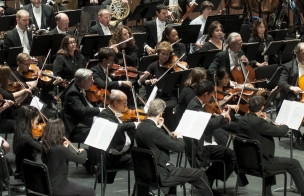While the Knoxville Symphony Orchestra’s artist booking policy often leans toward young artists at the beginning of careers, few of these have impressed and captivated in so many different ways as did soprano Emily Birsan in her appearance in the orchestra’s Masterworks concerts this weekend. Birsan was on hand for the bulk of the first half of the evening, first in Franz Schubert’s lied Der Hirt auf dem Felsen, followed by two Verdi arias, “Caro nome” from Rigoletto, and “È strano…Ah, fors’è lui…Sempre libera” from La Traviata.
Schubert wrote Der Hirt auf dem Felsen (The Shepherd on the Rock) from a request by soprano Pauline Anna Milder-Hauptmann but never heard it performed by her, dying a month after the work’s completion at the age of 31. The piece was originally written for soprano, clarinet, and piano, with the voice and clarinet essentially in a marvelous duet relationship. In this performance, the clarinetist was KSO principal, Gary Sperl; the KSO performed an orchestrated version by Carl Reinecke.
While one was immediately drawn to Birsan’s poise and effortless delivery, that respect leapt even higher as she dramatically carried the song’s narrative along, supported by clean, sophisticated tone and miraculously crisp diction. The vocal agility of Birsan was beautifully matched by the echoing flavor and spice from Sperl and the clarinet.
An even greater thrill, though, came from Birsan in the Verdi arias, a performance that revealed surprising reserves of power, depth and warmth in her lower range, and a thrilling goose-bump raising ability in her substantial upper range. This is a singer that will soon be snapped up hungrily by the international operatic world, if there is any justice at all.
The journey that was the satisfying second half of the KSO’s evening began in the dim light before dawn, climbed to the mountain heights through forest, glacier, and waterfall, braved untold dangers and a storm, only to return home at day’s end chastened by the ennobling experience. That journey was Richard Strauss’ programmatic tone poem, Eine Alpensinfonie, a fifty-minute-or-so exploration that I personally wouldn’t mind taking again and again.
At the time that Strauss returned to sketching out the work in 1911, a decade had passed since his last orchestral work, the ensuing years being consumed by operatic productions. A confluence of events probably provided much of the motivation for the works creation, not the least of which was the death of his friend and musical adversary, Gustav Mahler. Inspiration, too, came from his part-time home; Strauss kept a villa in the Bavarian mountain village of Garmisch.
Within the 22 sections of Eine Alpensinfonie, arranged chronologically from dawn to nightfall, are instrumental textures and colors of every possible description, from resplendent bursts of brass, to clarinet and flute birdcalls, to pastoral violin passages and cowbells, to gnarled and twisted undergrowth passages, to a harp waterfall and a wind machine storm. While the fascinating variety of instrumental effects in the KSO’s textural painting was endlessly entertaining, conductor Lucas Richman and orchestra seemed to bask in something greater: the work’s ability to draw the listener in to willing acceptance of lyrical descriptions twisted with modernist tonalities.
I enjoyed conductor Richman’s epic take on the work, giving each section’s descriptive textures the proper exposure and emphasis, light and darkness. I confess that I would have preferred a bit more in the way of nuanced tempo and dynamics to heighten the storytelling and balance out the inevitable gravitational pull of fortissimo playing. Nevertheless, the KSO’s Eine Alpensinfonie was a journey worth every minute of the dizzying and dazzling narrative.








